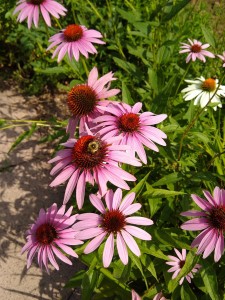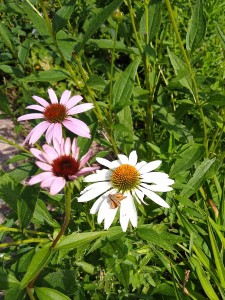 It occurs to me as I peer out over the happy array of coneflowers—Echinacea—in my front yard that the coneflower has become the “little black dress” of the world of ornamental horticulture. Every woman and a good number of the men of my acquaintance know that “little black dress” is metaphor for something that is appropriate for almost every situation, can be plain or embellished and can be elegant in its simplicity.
It occurs to me as I peer out over the happy array of coneflowers—Echinacea—in my front yard that the coneflower has become the “little black dress” of the world of ornamental horticulture. Every woman and a good number of the men of my acquaintance know that “little black dress” is metaphor for something that is appropriate for almost every situation, can be plain or embellished and can be elegant in its simplicity.
Coneflowers check all those boxes. Now, thanks to the combined efforts of merchandisers, plant breeders and public relations people, just about every gardener has access to coneflower varieties that suit their gardening ethos and style.
Suppose you are an organic gardener interested in tough, hardy native plants. You want something that will meld with your New Jersey tea, goldenrod and prairie-style grasses into a sustainable landscape. Your ideal plants never need supplemental water, even on summer days when a walk outside feels like being wrapped in a wet plastic shower curtain while imprisoned in a steamy bathroom.
Native coneflowers, like the three-foot pale purple coneflower—Echinacea pallida—are for you. The pale purple variety features elegantly drooping mauve-pink flower petals surrounding prominent cones. For something a little more purple and a little less droopy with the same ecological bona fides, you can grow the shorter and rarer Tennessee coneflower or Echinacea tennesseensis. Plants of this unusual variety, endemic to Tennessee, are not widely available, but if you are brave enough to let your grass grow long in the suburbs, you are brave enough to grow Tennessee coneflower from seed.
Purple coneflower or Echinacea purpurea is an ancestor of most of the modern coneflower hybrids, but it too will fit into your sustainable garden. Better yet, it is perky, purple and widely available.
But suppose you are a garden fashionista who wants either a specific garden color scheme, like orange and chartreuse, or a Lily Pulitzer-like array of large hot-hued daisies. If that is your inclination, you live in boom times. Since the 1990’s when hybridizers like Richard Saul of Itsaul Plants in Atlanta and Dr. Jim Ault, of the Chicago Botanic Garden in Illinois, began crossing various species of echinacea, the color range has exploded. You can now buy echinacea in shades like ‘Pow Wow White’ and ‘Coral Craze’, not to mention ‘Green Jewel’ and Kismet ‘Yellow’. In fact coneflowers are available in just about every shade except blue.
These colorful coneflowers, which began coming to the market in the early 2000s, may be taller or shorter than native or older varieties, and many, like ‘White Swan’ are fragrant as well. All are bred to be extremely floriferous with eye-catching cones. The flowers last for days, established plants need little or no supplemental water, and cut flowers survive nicely in arrangements for chic soirees, elegant picnics or the position of honor on the expensive granite countertop next to your Aga stove.
After the restrictions imposed by the COVID pandemic, some gardeners may feel the urge to go a little crazy with over-the-top varieties. For them there are the extravagant doubles that look like exploded chrysanthemums, the tone-toned spectaculars and the varieties with twisted petals.
First, the doubles, with flowers that remind me of the complicated hats worn by the late Queen Elizabeth, mother of the current English monarch. ‘Double Scoop ‘Orangeberry’, for example, is reddish orange, with a fluffy burst of short, tightly-packed petals that completely eclipse the center cone. ‘Puff Vanilla’ is the same thing in cream, and ‘Lemon Drop’ features a giant yellow topknot that looks as if it has beaten the small surrounding single petals into submission. The suggestively named ‘Fiery Meadow Mama’ is a two-tone, with single petals that are yellow shading to red towards the flowers’ centers, accenting the prominent central cones.
‘Green Twister’ is both bi-colored—green petals that shade to pink near the cone—with novelty petals shaped like slightly twisted, elongated spoons. The flowers are distinctive in any situation and might be quite beautiful in the right setting.
Though the array of coneflower varieties on the market is almost dizzying in number, color and variety, there truly is something for everyone—or almost everyone. If coneflowers are against your religion for some reason, try daylilies instead. Otherwise, find a good coneflower selection at your local garden center now. For fall planting go to Bluestone Perennials, 7211 Middle Ridge Rd. Madison, OH 44057; 800-852-5243; www.bluestoneperennials.com. Print catalog available.
